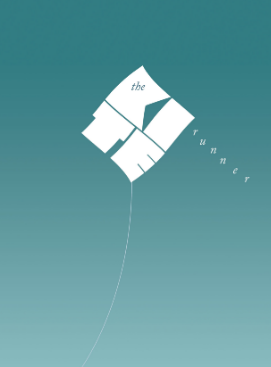THE KITE RUNNER
Every winter, districts in Kabul held a kite-fighting tournament, and if you were a boy living in Kabul, the day of the tournament was undeniably the highlight of the cold season. I never slept the night before the tournament. I’d roll from side to side, make shadow animals on the wall, even sit on the balcony in the dark with a blanket wrapped around me. I felt like a soldier trying to sleep in the trenches the night before a major battle. And that wasn’t so far off. In Kabul, fighting kites was a little like going to war.
As with any war, you had to ready yourself for its battles. For a while, Hassan and I used to build our own kites. We saved our weekly allowances in the fall, dropped the money in a little porcelain horse Baba had brought from Herat one time. When the winds of winter began to blow and snow fell in chunks, we undid the snap under the horse’s belly, went to the bazaar and bought bamboo, glue, string and paper. We spent hours every day shaving bamboo for the centre and cross spars, cutting the thin tissue paper which made dipping and recovery easy. And then, of course, we had to make our own string, or ‘tar’. If the kite was the gun, then tar, the glass-coated cutting line, was the bullet in the chamber. We’d go out in the yard and feed up to five hundred feet of string through a mixture of ground glass and glue. We’d then hang the line between the trees, leave it to dry. The next day, we’d wind the battle-ready line around a wooden spool. By the time the snow melted and the rains of spring swept in, every boy in Kabul bore telltale horizontal gashes on his fingers from a whole winter of fighting kites. I remember how my classmates and I used to huddle, compare our battle scars on the first day of school.
The kite-fighting tournament was an old winter tradition in Afghanistan. It started early in the morning on the day of the contest and didn’t end until only the winning kite flew in the sky. I remember one year the tournament outlasted daylight. People gathered on sidewalks and roofs to cheer for their kids. The streets filled with kite fighters, jerking and tugging on their lines, squinting up to the sky, trying to gain position to cut the opponent’s line. Every kite fighter had an assistant—in my case, Has-san—who held the spool and fed the line. The rules were simple: no rules. Fly your kite. Cut the opponents. Good luck.
Except, that wasn’t all. The real fun began when a kite was cut. That was where the kite runners came in, those kids who chased the windblown kite drifting through the neighbourhoods until it came spiralling down in a field, dropping in someone’s yard, on a tree or a rooftop. The chase got pretty fierce; hordes of kite runners swarmed the streets, shoved past each other like those people from Spain I’d read about once, the ones who ran from the bulls. And when a kite runner had his hands on a kite, no one could take it from him. That wasn’t a rule. That was the custom.
For kite runners, the most coveted prize was the last fallen kite of a winter tournament. It was a trophy of honour, something to be displayed on a mantle for guests to admire. When the sky cleared of kites and only the final two remained, every kite runner readied himself for the chance to land this prize. He positioned himself at a spot that he thought would give him a head start. Tense muscles readied themselves to uncoil. Necks craned. Eyes crinkled. Fights broke out. And when the last kite was cut, all hell broke loose.

